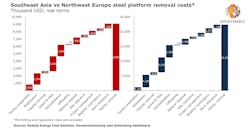North Sea conditions costlier for platform removals
Offshore staff
OSLO, Norway – Removing a steel platform in the North Sea, excluding subsea infrastructure, costs around twice as much as in Southeast Asia, according to analysis by Rystad Energy.
The consultant based its study on two similar steel platforms, one in each region, situated in 60 m (197 ft) of water with four piles, a topsides weight of 1,500 metric tons (1,653 tons) and a jacket weighing 800 metric tons (882 tons).
For the North Sea, removal would cost $22.35 million compared with $9.08 million in Southeast Asia, Rystad claimed. The main factors behind the discrepancy are higher spread rates and weather conditions.
The calculations include costs of heavy-lift vessels, support barges and tugs, and cutting/diving crews to remove the entire topsides in one piece.
Removal of the substructure is the costliest task as this depends on the age of the platform, the water depth, climate conditions, structural weight, the number of lifts required, and the number of piles.
For this study, based on a structure weighing less than 2,000 metric tons (2,205 tons), Rystad assumed that the four piles would be cut below the seafloor and the structures removed in a single lift, followed by delivery to shore on a transport barge for subsequent disposal.
In the case of the Southeast Asian field, a derrick barge with a 2,000-metric ton lift capacity would mobilize from Singapore, taking two days to reach the field location. In the North Sea, a dynamic positioning vessel, sailing for two days from Rotterdam, would be needed to withstand winds and waves in the region.
Day rates for a DP heavy lift vessel are typically 50% higher than for a derrick barge with the same lifting capacities, Rystad pointed out.
“The removal cost per platform can also vary within the same region depending on the time and scale of the decommissioning campaign,” added Sara Sottilotta, energy service analyst.
“Removing multiple facilities at the same time can help optimize costs by spreading the mobilization and demobilization costs across different assets.”
Flexibility around timing can also improve rates. Rystad expects vessel rates to reach their lowest point next year before rising again. And as the cost of disposal of materials depends heavily on the price of steel, flexibility on the disposal schedule could help bring down costs further (waiting until steel prices are high).
In the Southeast region, the consultant estimates that more than 280 offshore facilities are approaching the end of their lifetime. Most of the platforms due to be retired have topsides weighing less than 3,000 metric tons (3,307 tons) and are in water depths below 75 m (246 ft).
Most countries in the region do not have full decommissioning legislation in place, so projects are handled on a case-by-case basis. As an example. Petronas implemented a rigs-to-reef solution for two platforms at the Dana and D-30 fields offshore Malaysia in 2017.
The North Sea is a more mature market in terms of regulations for removal of offshore structures. Facilities there must be fully removed, in line with OSPAR Decision 98/3 requirements, which prohibit leaving in-situ of disused offshore installations.
09/10/2020
